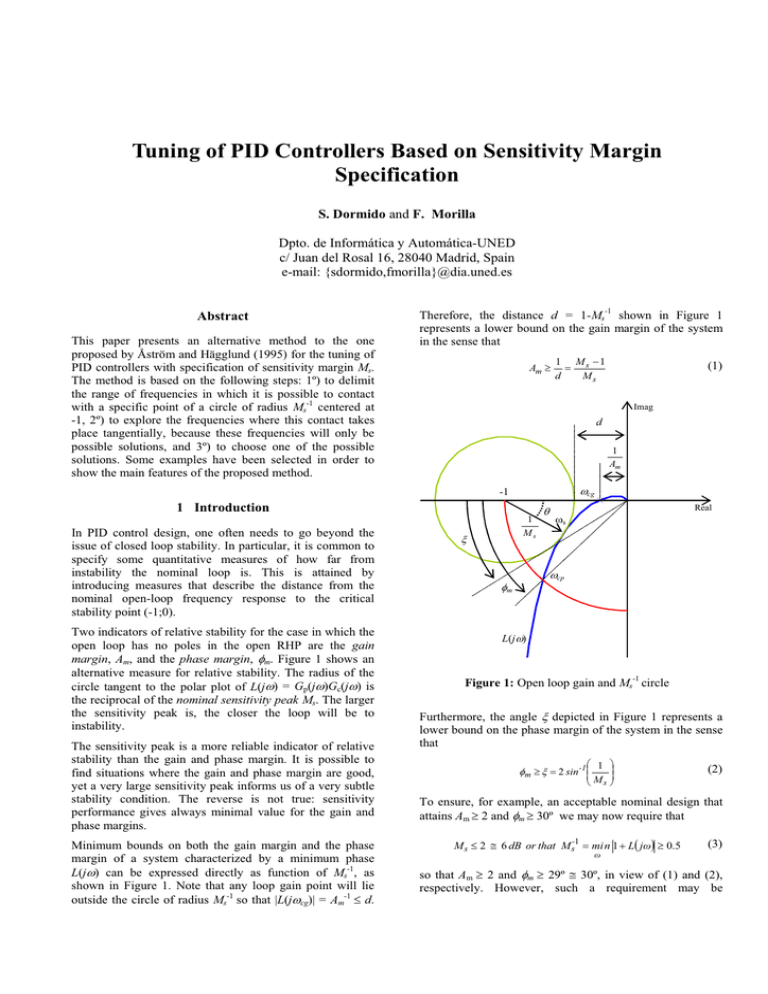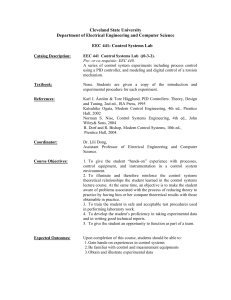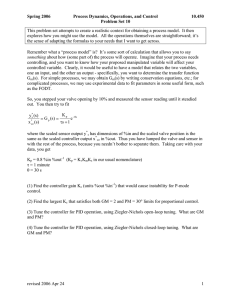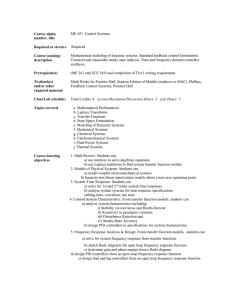Tuning of PID Controllers Based on Sensitivity Margin Specification
advertisement

Tuning of PID Controllers Based on Sensitivity Margin
Specification
S. Dormido and F. Morilla
Dpto. de Informática y Automática-UNED
c/ Juan del Rosal 16, 28040 Madrid, Spain
e-mail: {sdormido,fmorilla}@dia.uned.es
Abstract
This paper presents an alternative method to the one
proposed by Åström and Hägglund (1995) for the tuning of
PID controllers with specification of sensitivity margin Ms.
The method is based on the following steps: 1º) to delimit
the range of frequencies in which it is possible to contact
with a specific point of a circle of radius Ms-1 centered at
-1, 2º) to explore the frequencies where this contact takes
place tangentially, because these frequencies will only be
possible solutions, and 3º) to choose one of the possible
solutions. Some examples have been selected in order to
show the main features of the proposed method.
Therefore, the distance d = 1-Ms-1 shown in Figure 1
represents a lower bound on the gain margin of the system
in the sense that
Am t
1
d
Ms 1
Ms
Imag
d
1
Am
Zcg
-1
1 Introduction
In PID control design, one often needs to go beyond the
issue of closed loop stability. In particular, it is common to
specify some quantitative measures of how far from
instability the nominal loop is. This is attained by
introducing measures that describe the distance from the
nominal open-loop frequency response to the critical
stability point (-1;0).
Two indicators of relative stability for the case in which the
open loop has no poles in the open RHP are the gain
margin, Am, and the phase margin, Im. Figure 1 shows an
alternative measure for relative stability. The radius of the
circle tangent to the polar plot of L(jZ) = Gp(jZ)Gc(jZ) is
the reciprocal of the nominal sensitivity peak Ms. The larger
the sensitivity peak is, the closer the loop will be to
instability.
The sensitivity peak is a more reliable indicator of relative
stability than the gain and phase margin. It is possible to
find situations where the gain and phase margin are good,
yet a very large sensitivity peak informs us of a very subtle
stability condition. The reverse is not true: sensitivity
performance gives always minimal value for the gain and
phase margins.
Minimum bounds on both the gain margin and the phase
margin of a system characterized by a minimum phase
L(jZ) can be expressed directly as function of Ms-1, as
shown in Figure 1. Note that any loop gain point will lie
outside the circle of radius Ms-1 so that |L(jZcg)| = Am-1 d d.
(1)
1
Ms
[
T
Real
Zs
Zcp
Im
L(jZ)
Figure 1: Open loop gain and Ms-1 circle
Furthermore, the angle [ depicted in Figure 1 represents a
lower bound on the phase margin of the system in the sense
that
Im t [
§ 1 ·
¸
2 sin -1 ¨¨
¸
© Ms ¹
(2)
To ensure, for example, an acceptable nominal design that
attains Am t 2 and Im t 30º we may now require that
M s d 2 # 6 dB or that M s-1
mi n 1 L jȦ t 0.5
(3)
Ȧ
so that Am t 2 and Im t 29º # 30º, in view of (1) and (2),
respectively. However, such a requirement may be
conservative, since larger values of Ms-1 can imply both
Am > 2 and Im > 30º.
Note that the single sensitivity function requirement defined
by (3) can be used to replace both the Am and the Im
requirements not only in the minimum phase cases but also
in the unstable and non minimum phase cases as well. In
particular, (3) will ensure that L(jZ) remains an acceptable,
“marginal” distance away from the critical -1 point,
irrespective of the number and the direction of
encirclements required for closed loop stability; that is, (3)
will ensure robust stability with respect to plant parameter
variations once nominal closed-loop stability has been
obtained.
The paper is organized as follows. Section 2 is devoted to
introduce basic concepts of tuning of PID controllers in the
frequency domain. In section 3 the tuning of PID controller
when the design criterion is to obtain a specified sensitivity
Ms is explained in a detailed way. Some illustrative
examples are described in section 4. Finally section 5
presents some conclusions.
2 Tuning of PID in the frequency domain
Some frequency domain tuning methods of PID controllers
(Åström and Hägglund (1995), Morilla and Dormido
(2000)) can be interpreted in terms of moving one point A
in the frequency response of the process Gp(jZ) to an
arbitrary point B. This point B is the specification or is
determined by the specification (phase margin, gain
margin). Therefore, once point B has been fixed there is a
range of frequencies in the Nyquist plot of Gp(jZ) where it
is possible to find a solution. This range can be determined
from the following angular condition:
Icmin
max
d (IB - I(Z)) d Ic
(4)
IB - 270º
Imag
Zmax
1
Real
Zmin
IB
Gp(jZ)
IB - 180º
Possible
points A
Possible
points B
IB - 90º
Figure 2: Range for the design frequency
Figure 3 shows the interpretation of the tuning by combined
phase-gain margin. The tuning procedure can be seen as the
change, in the complex plane, of two points (A and D) on
Gp(jZ) into points (B and E) on L(jZ). Figure 4 shows the
interpretation of this tuning procedure in the parametric
plane KP (proportional gain) - KI (integral gain), (Shafiei
and Shenton, 1997).
Imag
1
1
Am
E
1
Real
D
Im
Gp(jZ)
where IB and I(Z) are the phase of point B and Gp(jZ), with
min
1
B
A
max
respect to the negative real axis, and Ic and Ic
are the
minimum and maximum angular contributions of the
controller. The range of frequencies depends therefore on
the type of controller to be tuned.
Figure 2 shows an example, where the controller is a PID
controller. Point B belongs to the bisector of the third
quadrant, and the possible points A are represented in
continuous trace (Zmin and Zmax delimitate the corresponding range of frequencies). The example includes as a
particular case a specification of phase margin equal to 45º
(point B is located on the unit circle).
Another important consideration in Morilla and Dormido
(2000) was the convenience of using an auxiliary criterion
(the maximum integral gain) together with the specification
of phase or gain margin to choose the design frequency
among all the possible solutions. However this constraint is
not necessary when the tuning is made by combining both
specifications.
L(jZ)
Figure 3: PID tuning by combined phase-gain margin
KI
Zd
Za
Zdmin
Zamax
Zdmax
Zamin
KP
Figure 4: PID tuning in the parametric plane
3 Tuning of PID with specification of Ms.
a Ȧ, ș I' Ȧ In (Aström and Hägglund (1995)) the design criterion is to
obtain a specified sensitivity Ms (see Figure 5) with good
rejection of load disturbances. From the numerical point of
view the procedure is reduced to the resolution of a system
of three non-linear equations with five unknowns: the three
PID controller parameters KP, KI and KD, the frequency Z in
which the specified sensitivity will take place and the angle
T where the contact with the circle Ms will happen.
For the resolution of these equations they propose to use an
optimization procedure, combined either with the maximum
integral gain criterion or the maximum frequency; the value
of T is bounded to the interval [0 S/2].
Imag
1
IB
rs TB
B
Gp(jZ)
L(jZ)
Figure 5: Nyquist plot of Gp(jZ) and L(jZ)
The system of equations, with certain changes with respect
to the formulation of Aström and Hägglund (1995), is the
following:
ª
º
cosT
§ KI
·
K D Ȧ¸ sinI Ȧ»rȦ - 1 «- K P cosI Ȧ ¨
Ms
© Z
¹
¬
¼
1
Ȧ
2
cȦ, ș 1 Ȧ r' Ȧ
Ȧ I' Ȧ cotan ș I Ȧ
r Ȧ
3.1 New tuning procedure of PID controllers
The method for tuning consists of the following steps:
a) To specify exactly the point where the contact with the
circle Ms will take place.
b) To determine the family of controllers able to make
L(jZ) pass through the specified point.
c) To use the tangency condition (the proposal given by
Aström and Hägglund (1995) or a simpler one given in
this paper), to determine those controllers that
guarantee the tangential contact with the specified
point on circle Ms.
d) To choose one of the possible controllers.
Point B can be specified completely if specification Ms is
accompanied by angle TB in which the contact will take
place (see Figure 5). Point B is perfectly located in the
complex plane by means of its real and imaginary part (XB,
YB) or its magnitude and phase (rB, IB) whose dependence
with respect to rs= Ms-1 and TB is given in the following
expressions
XB = -1 + rs cos TB = - rB cos IB
YB = - rs sen TB = - rB sen IB
(5)
tg I B
KI
ª
º
«- K P K D Ȧ sinI Ȧ Z cos I Ȧ»rȦ
¼
¬
a Ȧ,ș K P bȦ,ș K I cȦ,ș K D
-
sinT
Ms
rs sen ș B
rs cos ș B - 1
(9)
(6)
rB
0
r' Ȧ I' Ȧ cotan ș I Ȧ
Ȧ r Ȧ
Ȧ
Next it is described how the contact point can be specified,
how the family of controllers can be determined and
represented, and how the tangency condition can be
formulated. Other aspects, related with practical application
of the tuning method and the choice of the controllers, are
discussed in the next section together with the different
steps of the proposed algorithm.
Real
rB
bȦ, ș r' Ȧ
cotan ș I Ȧ
r Ȧ
(7)
(5) and (6) equations impose the contact of L(jZ) with the
circle Ms, with an angle T, while (7) imposes the tangency
condition.
r(Z) and I(Z) are the magnitude and the phase of Gp(jZ),
a(Z,T), b(Z,T) and c(Z,T) are three functions used to
abbreviate equation (7) that depend on the derivatives r´(Z),
I´(Z) of the magnitude and phase of Gp(jZ) as shown in the
following expressions:
rs sen ș B
sen I B
(10)
The parameters of the PID controllers that are able to make
L(jZ) pass through point B can be obtained by applying the
following expressions (Morilla and Dormido, 2000):
K P Ȧ TI Ȧ
rB cos I B I Ȧ r Ȧ 1 §
¨ tg I B I Ȧ +
2ĮȦ ©
(11)
4 Į + tg 2 I B I Ȧ ·¸ (12)
¹
TD Ȧ = Į TI Ȧ (13)
in the range of frequencies that verify the angular condition
(4). Equation (9) admits this other equivalent expression:
rB sen I B
1 - rB cos I B
five points Z-2'Z, Z-'Z, Z, Z+'Z y Z+2'Z, due to the
following approximation for the calculation of the
derivative rL(Z) and IL(Z) in point B (Savitzky and Golay,
1964)
(14)
d f Ȧ f Ȧ 2'Ȧ - 8 f Ȧ 'Ȧ 8 f Ȧ 'Ȧ - f Ȧ 2'Ȧ
#
(17)
12'Ȧ
dȦ
The tangent to circle Ms in a point (Xs, Ys) is a function of
the angle T that can be obtained as follows:
it is also convenient to make sure that rL(Z) and IL(Z)
coincide with values rB and IB determined in Step 2.
d - rs sen ș - rs cos ș
1
dș
d - 1 rs cos ș - rs sen ș tg ș
dș
The tangent to L(jZ) is a function of the frequency Z that
can be obtained as follows:
x Calculate the derivatives r´B(Z) and I´B(Z), using the
generic approximation (17)
tg ș B
d Ys
d Xs
d Imag >L jȦ@
d Real >L jȦ@
d rL Ȧ
d I L Ȧ
sen I L Ȧ - rL Ȧ
cos I L Ȧ
dȦ
dȦ
d r Ȧ
d I L Ȧ
- L
cos I L Ȧ rL Ȧ
sen I L Ȧ
dȦ
dȦ
-
The equality of both tangents in the point B give us the
following expression for TB:
tg ș B
rBc Ȧ cos I B - rB I Bc Ȧ sen I B
rBc Ȧ sen I B rB I Bc Ȧ cos I B
(15)
where r´B(Z) and I´B(Z) represent the value of the
derivative of the magnitude and phase of L(jZ) in the point
B respectively.
Equaling equations (14) and (15) gives the following
condition that must fulfill the magnitude and phase of point
B and the respective derivatives of L(jZ) in point B.
rB rBc Ȧ rBc Ȧ cos I B - rB I Bc Ȧ sen I B
(16)
3.2 Tuning algorithm of PID controllers
Given the plant Gp(jZ), the PID parameters can be tuned to
meet a specified Ms in the following way:
Step 1: Initialization. The user specifies the value of Ms and
the angle TB in order to locate point B and chooses the
controller's type, PI or PID. In the last case specifies D
(D = TD/TI).
Step 2: Calculate IB and rB by using (9) and (10).
Step 3: Calculate the range of frequencies, using the
expression (4), where L(jZ) may pass through point B.
Step 4: Sweep the whole range of frequencies in order to
determine in which frequencies the tangency condition is
fulfilled. This sweeping makes the following calculations
for all and each one of the frequencies:
x Calculate the control parameters by means of (11), (12)
and (13).
x Calculate the magnitude rL(Z) and phase IL(Z) of L(jZ) in
the vicinity of the design frequency, in particular in the
x Evaluate the tangency condition, using the following
quadratic function:
FCT Ȧ rB rBc Ȧ rBc Ȧ cos I B rB I Bc Ȧ sen I B 2 (18)
Step 5: Choose the frequency and the corresponding
parameters assigned to the controller. This selection is not
trivial, because, as it will be seen in the examples, the
tuning for a specified sensitivity can have a unique or a
multiple solution. In the case of a unique solution, the
condition of minimum of function FCT is sufficient in order
to determine it. However in the case of a multiple solution
the search inside a tolerance is the only way to find several
zones that contain the different solutions. It is also
necessary to use an auxiliary criterion (i.e. the absolute
minimum FCT, the maximum integral gain, or the relative
minimum FCT in the high frequencies zone) to select the
frequency solution.
If the tangency condition of Aström and Hägglund (1995) is
used it is only necessary to modify step 4 lightly calculating
the magnitude r(Z) and the phase I(Z) of Gp(jZ) and their
derivatives in the vicinity of the design frequency, by
applying the following quadratic function:
FCT Ȧ
aȦ,ș K P bȦ,ș K I
cȦ,ș K D 2
(19)
where a(Z,T), b(Z,T) and c(Z,T) are evaluated using the
expressions (8).
4 Examples
Let be the third order process evaluated by Persson (1992):
G p (s)
0.3
s 0.3 s 2 0.6s 1
The problem consists in tuning a PI controller with the
following specifications: Ms = 2 and TB = 30º. Figure 6
shows how the tangency condition FCT varies in the whole
range of frequencies where there is contact with point B.
With a logarithmic sweeping of 100 points, only in the
range of 0.53 to 0.57 rd/s does the tangency condition
remain below the chosen tolerance (0.001). The minimum
of FCT is presented at the frequency Zc = 0.553 rd/s and the
controller parameters KP = 0.36, TI = 0.69 and TD = 0 are
obtained.
0.45
parametric plane (KP, KI) allow to observe where the two
families of controllers meet the specifications.
0.4
Nyquist Diagram
0.35
2
FCT
0.3
1.5
0.25
0.2
1
0.15
0.05
0
0.3
0.4
0.5
0.6
0.7
0.8
0.9
1
0.5
Imaginary axis
0.1
0
-0.5
Zc
-1
Figure 6: Tangency condition with the PI controller
-1.5
Figure 7 shows a graph in the parametric plane (KP,KI) with
all the couples that allow contact with the circle Ms = 2 at
the point TB = 30º. Those couples that also allow tangential
contact with a tolerance less than 0.001 are marked with
circles. In the crossing point of the horizontal and vertical
lines we find the couple of parameters that is able to
minimize the tangency condition.
-2
-2
-1.5
-1
-0.5
0
0.5
Real axis
1
1.5
2
Figure 8: Tuning for maximum sensitivity
Setpoint and output process
2
0.7
KI
1.5
0.6
1
0.5
0.5
0
0.4
0
10
20
30
40
50
60
40
50
60
Control signal
0.3
2
1.5
0.2
1
0.5
0.1
0
0
0
0.2
0.4
0.6
0.8
1
1.2
1.4
-0.5
KP
Figure 8 shows the Nyquist diagram of the process and the
result of the tuning. The circle corresponds to the
specification of sensitivity and the radius is associated to
point B in which the contact and the tangency with this
circle take place. A more accurate numeric analysis allows
to check that the desired sensitivity specification has been
obtained. Figure 9 shows the process output and the control
signal responses to steps in the set point and load
disturbances.
Figures 10 and 11 show the results for a PID controller with
ratio D = TD/TI =0.1. Due to the form of the FCT tangency
condition, it is observed that now it is possible to contact
with point B in a logically bigger range of frequencies, and
that two sub ranges exist where the tangency condition
remains below the tolerance chosen (0.01); these sub ranges
are [0.54 0.58] and [1.18 1.20]. The circles marked in the
10
20
30
Figure 9: Process output and control signal response
0.35
0.3
0.25
0.2
FCT
Figure 7: Tuning for maximum sensitivity
0
0.15
0.1
0.05
0
0
0.5
1
1.5
2
2.5
Zc
Figure 10: Tangency condition for the PID controller
circle of radius Ms-1 centered at -1, 2º) to explore the
frequencies where this contact takes place tangentially,
because these frequencies will only be possible solutions
and 3º) to choose one of the possible solutions. Some
examples have been selected in order to show the main
features of the proposed method.
0.7
KI
0.6
0.5
0.4
Setpoint and output process
1.8
0.3
1.6
0.2
Zc =0.561
1.4
0.1
0
1.2
1
0
0.2
0.4
0.6
0.8
1
1.2
1.4
1.6
1.8
KD
2
0.8
Zc=1.20
Figure 11: Tangency condition for the PID controller
Figure 12 shows a comparative graph between two possible
PID tuning; the first one corresponds to the absolute
minimum of FCT at Zc = 0.561 rd/s, and the second to the
relative minimum of the other subrange at Zc = 1.20 rd/s.
0.6
0.4
0.2
0
0
10
20
30
40
50
60
Nyquist Diagram
2
Figure 13: Set point and load disturbances responses
1.5
Acknowledgements
Zc=1.20
1
Imaginary axis
Zc =0.561
This work has been supported by the Spanish CICYT under
grant DPI 2001-1012.
0.5
0
References
-0.5
-1
-1.5
-2
-2
-1.5
-1
-0.5
0
0.5
Real axis
1
1.5
2
Figure 12: Tangency condition for the PID controller
With the controller parameters of the first tuning, KP = 0.37,
TI = 0.7 and TD = 0.07, almost identical to the one obtained
with the PI controller, the specified sensitivity is obtained.
With the controller parameters of the second tuning,
KP = 1.62, TI = 8.2 and TD = 0.82 the specified sensitivity is
also obtained. But by observing the comparative graph of
the time response in Figure 13 it can be concluded that the
first tuning is preferable to the second, because it allows to
reach the reference and to reject the load disturbance in a
shorter time and with a smaller control effort.
5. Conclusions
The objective of this paper is to present an alternative
method to the one proposed by Åström and Hägglund
(1995) for the tuning of PID controllers with specification
of sensitivity margin Ms. The method is based on the
following steps: 1º) to delimit the range of frequencies in
which it is possible to contact with a specific point of a
[1] Aström, K.J. and T. Hägglund (1995). PID
Controllers: Theory, Design, and Tuning (2nd
Edition). Research Triangle Park, NC: Instrument
Society of America.
[2] Dormido, S. (2002). Control Learning: Present and
Future. Plenary lecture. Preprints of b’02 15th World
Congress of IFAC, Barcelona 21-26 july.
[3] Morilla, F. and S. Dormido (2000). Methodologies for
the tuning of PID controllers in the frequency domain.
PID'00 IFAC Workshop on Digital Control: Past,
present and future of PID Control, 155-160, Terrassa.
[4] Morilla, F., A. Fernández and S. Dormido Canto
(2001). Control systems analysis & design server.
IBCE'01 IFAC Workshop on Internet Based Control
Education, 151-156, Madrid.
[5] Persson, P. (1992). Towards Autonomous PID
Control. Doctoral Dissertation. Department of
Automatic Control, Lund Institute of Technology.
[6] Savitzky and Golay (1964). Smoothing and
differentiation of dates by simplified least squares
procedures. Analytical Chemistry, vol. 36, nº8, july
1964.
[7] Shafiei, Z. and A.T. Shenton (1997). Frequencydomain Design of PID Controllers for Stable and
Unstable Systems with Time Delay. Automatic, 22232232.


